Agathocles Of Syracuse: Sicilian Ruler Who Committed Numerous Crimes Saved And Extended Sovereignty Of Sicily
David Tee - AncientPages.com - From humble beginnings rose a man who many throughout history have called a tyrant. Agathocles’ birth is not recorded but his father was a humble potter and Agathocles learned that trade as well.
His father moved to Syracuse in about 343 BC but that would be long after Agathocles’ birth as in 333 BC, the son married. He chose the widow of his patron, Damas, to be his bride.
Litra of silver struck by Agathocles then tyrant of Syracuse (317-294 AC), representing at right a head of Athena and at the back a Pegasus with, under the belly, the triskeles which refers to Agathocles. source
Agathocles’ early life was not a peaceful one as he was never satisfied with the oligarchical rule that governed Syracuse. He led two unsuccessful rebellions that ended up with him being banned from the city.
Agathocles Could Never Be Trusted
In Agathocles’ return to Syracuse in 317 BC, he was at the head of an army. His advance on the city and eventual success at overthrowing the current rulers was based on a promise that he would observe and support democratic processes.
He did not and when the time was right, he killed roughly 10,000 of the Syracuse citizens to make sure he had complete and total control over the city and its people. After this treachery, Agathocles spent the next few years gaining control over different Greek cities in Sicily.
Once he had conquered these cities, Agathocles was placed in direct opposition to the rulers of Carthage. From 311 on to 309 BC, Agathocles waged war against the Carthaginians.
In one battle, he made an ally of Ophellas of Cyrenaica. The latter ruler recruited a strong army and after a 2 month march was able to join Agathocles and the two armies camped side by side.
Unfortunately, this was an error in judgment on the part of Ophellas as Agathocles attacked his ally, killing him in the battle. With Ophellas out of the way, Agathocles took possession of Ophellas’ army.
Military Encounter With Carthaginians
Reinforced by the assumption of his ally’s army, Agathocles was able to turn the war against Carthage in his favor. He did this by taking part of his army past a Carthaginian blockade and landed in Carthage’s territory in approx. 310 BC.
Agathocles’ Carthaginian enemy was Hamilcar (c. 275–228 BC), a general and statesman, leader of the Barcid family, and father of Hannibal, who heard about what was happening in his homeland so he sent about 5,000 troops home to fight off Agathocles’ advances.
 Dekadrachm - 50 Litrai, Philippeios type, 317-311, Agathokles, Syracuse. source
Dekadrachm - 50 Litrai, Philippeios type, 317-311, Agathokles, Syracuse. source
But Hamilcar made an error in military judgement with this move.
Agathocles learned of the troop movement and was waiting for the Carthaginian forces when they landed. A short battle and Agathocles’ enemy was destroyed. Then with the lack of men in Sicily, Agathocles’ brother Antander defeated Hamilcar and captured him.
Hamilcar did not survive the torture inflicted upon him by Antander. The sea power of the Carthaginians was the only factor that stopped Agathocles from conquering Carthage itself. But with rebellion by different Greek cities on Sicily, Agathocles was forced to return to protect his territory.
Fighting On Sicily
Once he returned to his home country, Agathocles was able to take part of the northwest section of Sicily and put it under his control. But the Greek cities had gained power while he was a way and they defeated Agathocles in battle.
Despite commuting between Carthage and Sicily, Agathocles could not sustain his advantage and the Carthaginians were able to defeat his son in battle. Troops started to defect, so Agathocles left Carthage forever abandoning his army and his son to their fate. His son was killed by his own men, who sued for peace with the people of Carthage.
Facing two enemies back in Sicily was not a smart military move, so Agathocles tried to make peace. The Greek cities declined the offer to their regret. Once Agathocles made peace with the Carthaginians, he was able to use his very inferior but experienced force to defeat - the leaders of those Greek cities.
Agathocles became the ruler of Sicily once again in 306 BC.
The Controversy Surrounding His Death
History does not record the exact causes of Agathocles’ death. Some people say he was poisoned while others claim that he died of natural causes. What is sure is that as Agathocles got older, he suffered from ill health.
As he grew closer to death, Agathocles restored the old Syracusan democracy and stopped his sons from succeeding him as king.
Updated on September 3, 2024
Written by – David Tee AncientPages.com Staff Writer
Copyright © AncientPages.com All rights reserved. This material may not be published, broadcast, rewritten or redistributed in whole or part without the express written permission of AncientPages.com
Expand for referencesReferences:
Tillyard H.J.W. The History of Agathocles
Kahn, Victoria. "Revisiting Agathocles." The Review of Politics 75, no. 4 (2013): 557-72
More From Ancient Pages
-
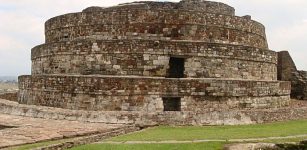 Ehecatl: The Snake-Bird Deity And God Of Wind Feared And Respected By The Aztecs
Aztec Mythology | Aug 26, 2016
Ehecatl: The Snake-Bird Deity And God Of Wind Feared And Respected By The Aztecs
Aztec Mythology | Aug 26, 2016 -
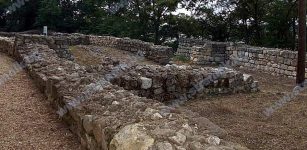 Fortress Wall Of Ancient Roman City Of Sexaginta Prista Discovered
Archaeology | Apr 16, 2016
Fortress Wall Of Ancient Roman City Of Sexaginta Prista Discovered
Archaeology | Apr 16, 2016 -
 World’s Oldest And Largest Maya Structure Revealed By LIDAR
Archaeology | Jun 9, 2020
World’s Oldest And Largest Maya Structure Revealed By LIDAR
Archaeology | Jun 9, 2020 -
 Unusual Ancient Skull Found In Chan Hol Underwater Cave Reveals Early American Settlers Were Morphologically Different
Archaeology | Feb 6, 2020
Unusual Ancient Skull Found In Chan Hol Underwater Cave Reveals Early American Settlers Were Morphologically Different
Archaeology | Feb 6, 2020 -
 Ancient Mystery In The Alpes Remains Unsolved Because Of Contradicting Information
Ancient Mysteries | May 15, 2018
Ancient Mystery In The Alpes Remains Unsolved Because Of Contradicting Information
Ancient Mysteries | May 15, 2018 -
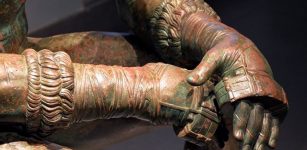 Boxer At Rest – Rare Sculpture And Masterpiece Of Hellenistic Bronze Art
Artifacts | May 21, 2021
Boxer At Rest – Rare Sculpture And Masterpiece Of Hellenistic Bronze Art
Artifacts | May 21, 2021 -
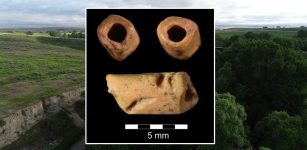 Oldest Bead In America Discovered At La Prele Mammoth Site, Wyoming
Archaeology | Feb 13, 2024
Oldest Bead In America Discovered At La Prele Mammoth Site, Wyoming
Archaeology | Feb 13, 2024 -
 Stunning CGI Reconstruction Of Saint Thomas Becket’s Shrine
Archaeology | Jul 7, 2020
Stunning CGI Reconstruction Of Saint Thomas Becket’s Shrine
Archaeology | Jul 7, 2020 -
 Secrets Of Quipu – Ancient Inca Message Decoded By Student
Archaeology | Dec 27, 2017
Secrets Of Quipu – Ancient Inca Message Decoded By Student
Archaeology | Dec 27, 2017 -
 Link Between Changes In Evolution And Climate Discovered
Archaeology | Oct 4, 2022
Link Between Changes In Evolution And Climate Discovered
Archaeology | Oct 4, 2022 -
 Mysterious Mustatils- Giant 7,000-Year-Old Stone Monuments In Saudi Arabia Baffle Scientists
Archaeology | Aug 19, 2020
Mysterious Mustatils- Giant 7,000-Year-Old Stone Monuments In Saudi Arabia Baffle Scientists
Archaeology | Aug 19, 2020 -
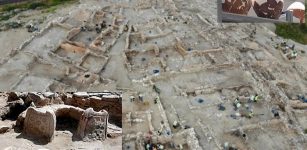 Anatolia’s Seyitömer Mound Was Inhabited In Bronze Age, Achaemenid, Hellenistic, And Roman Times
Archaeology | Aug 17, 2020
Anatolia’s Seyitömer Mound Was Inhabited In Bronze Age, Achaemenid, Hellenistic, And Roman Times
Archaeology | Aug 17, 2020 -
 DNA Sheds New Light On The Mysterious Dead Sea Scrolls
Archaeology | Jun 2, 2020
DNA Sheds New Light On The Mysterious Dead Sea Scrolls
Archaeology | Jun 2, 2020 -
 Beads Show European Trade In African Interior Used Indigenous Routes
Archaeology | Sep 17, 2022
Beads Show European Trade In African Interior Used Indigenous Routes
Archaeology | Sep 17, 2022 -
 Neanderthal Intelligence Revealed By Their Use Of Fire For Cooking
Archaeology | Oct 13, 2023
Neanderthal Intelligence Revealed By Their Use Of Fire For Cooking
Archaeology | Oct 13, 2023 -
 Cooper’s Ferry Site In Western Idaho Was Inhabited 16,000 Years Ago
Archaeology | Sep 3, 2019
Cooper’s Ferry Site In Western Idaho Was Inhabited 16,000 Years Ago
Archaeology | Sep 3, 2019 -
 Stone Age Settlement Discovered Underwater In Finland
Archaeology | Aug 9, 2018
Stone Age Settlement Discovered Underwater In Finland
Archaeology | Aug 9, 2018 -
 Evidence Ravens Share A 30,000-Year-Old Relationship With Humans
Archaeology | Jul 14, 2023
Evidence Ravens Share A 30,000-Year-Old Relationship With Humans
Archaeology | Jul 14, 2023 -
 Gold Treasures Of Ancient King Discovered In North America Create Historical Problems
Ancient Mysteries | Jun 29, 2018
Gold Treasures Of Ancient King Discovered In North America Create Historical Problems
Ancient Mysteries | Jun 29, 2018 -
 When Science, Spirituality and Magic Meet – Re-Discovering Old Ancient Knowledge
Featured Stories | Feb 18, 2020
When Science, Spirituality and Magic Meet – Re-Discovering Old Ancient Knowledge
Featured Stories | Feb 18, 2020

